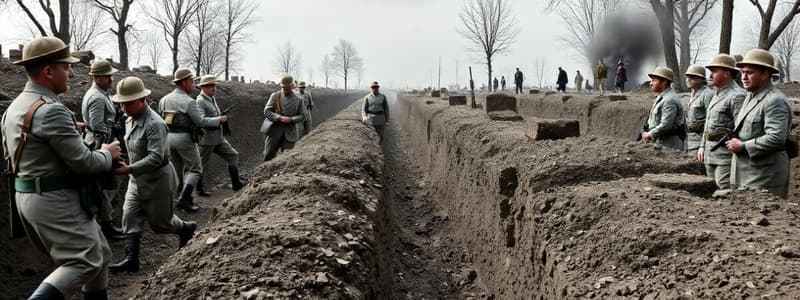Podcast
Questions and Answers
What was the main purpose of the Von Schlieffen Plan?
What was the main purpose of the Von Schlieffen Plan?
- To avoid a two-front war by defeating France quickly (correct)
- To promote alliances with Italy
- To initiate a naval blockade against the UK
- To establish a peace treaty with Russia
Which of the following best describes the term 'total war'?
Which of the following best describes the term 'total war'?
- A conflict that involves only professional soldiers
- A military tactic that avoids civilian areas
- A war that requires contributions from civilians and impacts the entire nation (correct)
- A war strategy that focuses solely on military targets
What led to the United States entering World War II?
What led to the United States entering World War II?
- The signing of the Munich Agreement
- The sinking of the Lusitania
- The German invasion of Poland
- The attack on Pearl Harbor by Japan (correct)
Which political leaders were prominent during the Great Depression?
Which political leaders were prominent during the Great Depression?
What characterized trench warfare during World War I?
What characterized trench warfare during World War I?
Which organization was established after World War II to maintain international peace?
Which organization was established after World War II to maintain international peace?
What was the strategy known as Blitzkrieg primarily associated with?
What was the strategy known as Blitzkrieg primarily associated with?
What does the term Mutually Assured Destruction (MAD) imply?
What does the term Mutually Assured Destruction (MAD) imply?
What was the outcome of the On-to-Ottawa Trek in 1935?
What was the outcome of the On-to-Ottawa Trek in 1935?
Which event directly prompted the United States to enter World War II?
Which event directly prompted the United States to enter World War II?
What was the primary strategy used by Germany known as Blitzkrieg?
What was the primary strategy used by Germany known as Blitzkrieg?
Which of the following statements best defines fascism?
Which of the following statements best defines fascism?
What was the objective of the Marshall Plan?
What was the objective of the Marshall Plan?
What was the significance of D-Day during World War II?
What was the significance of D-Day during World War II?
What does the term Holocaust refer to?
What does the term Holocaust refer to?
What does the concept of Mutually Assured Destruction imply?
What does the concept of Mutually Assured Destruction imply?
What role did Robert Oppenheimer have during the Manhattan Project?
What role did Robert Oppenheimer have during the Manhattan Project?
Which event does VE Day commemorate?
Which event does VE Day commemorate?
What was the significance of the Iron Curtain during the Cold War?
What was the significance of the Iron Curtain during the Cold War?
Which event is known for its impact on women's suffrage in Canada?
Which event is known for its impact on women's suffrage in Canada?
What was the primary purpose of residential schools in Canada?
What was the primary purpose of residential schools in Canada?
What role did the U.S. play in the Marshall Plan?
What role did the U.S. play in the Marshall Plan?
Which of the following best describes trench warfare?
Which of the following best describes trench warfare?
What was one of the main economic tools used during WWI and WWII to raise funds?
What was one of the main economic tools used during WWI and WWII to raise funds?
What characterized the cultural movement of the Hippies in the 1960s?
What characterized the cultural movement of the Hippies in the 1960s?
What was a primary result of the Winnipeg General Strike of 1919?
What was a primary result of the Winnipeg General Strike of 1919?
Who were the Alberta Five?
Who were the Alberta Five?
What was the key ideological difference between fascism and communism?
What was the key ideological difference between fascism and communism?
What was one of the main focuses of the Baby Boomers generation?
What was one of the main focuses of the Baby Boomers generation?
What does the term 'total war' imply?
What does the term 'total war' imply?
What was the main objective of the League of Nations?
What was the main objective of the League of Nations?
Which of the following was a consequence of the War Guilt Clause in the Treaty of Versailles?
Which of the following was a consequence of the War Guilt Clause in the Treaty of Versailles?
Flashcards
Axis Powers
Axis Powers
The alliance of Germany, Italy, and Japan during World War II.
Allied Powers
Allied Powers
The countries fighting against the Axis Powers, including the U.S., UK, and Soviet Union.
Superpower Nation
Superpower Nation
A powerful country with significant global influence, like the U.S. and Soviet Union during the Cold War.
Atomic Warfare
Atomic Warfare
Signup and view all the flashcards
Fascism
Fascism
Signup and view all the flashcards
Dictator
Dictator
Signup and view all the flashcards
Nazism
Nazism
Signup and view all the flashcards
Propaganda
Propaganda
Signup and view all the flashcards
Mein Kampf
Mein Kampf
Signup and view all the flashcards
Holocaust
Holocaust
Signup and view all the flashcards
The Great Depression
The Great Depression
Signup and view all the flashcards
Total War
Total War
Signup and view all the flashcards
Blitzkrieg
Blitzkrieg
Signup and view all the flashcards
Trench Warfare
Trench Warfare
Signup and view all the flashcards
The Holocaust
The Holocaust
Signup and view all the flashcards
Pearl Harbor
Pearl Harbor
Signup and view all the flashcards
D-Day
D-Day
Signup and view all the flashcards
Cold War
Cold War
Signup and view all the flashcards
Trench
Trench
Signup and view all the flashcards
No Man's Land
No Man's Land
Signup and view all the flashcards
Front Trench
Front Trench
Signup and view all the flashcards
Assimilation
Assimilation
Signup and view all the flashcards
Union
Union
Signup and view all the flashcards
General Strike
General Strike
Signup and view all the flashcards
Colony
Colony
Signup and view all the flashcards
Monarchy
Monarchy
Signup and view all the flashcards
Autonomy
Autonomy
Signup and view all the flashcards
War
War
Signup and view all the flashcards
Nationalism
Nationalism
Signup and view all the flashcards
Militarism
Militarism
Signup and view all the flashcards
The Black Hand
The Black Hand
Signup and view all the flashcards
Von Schlieffen Plan
Von Schlieffen Plan
Signup and view all the flashcards
Study Notes
World War I (WWI) Causes
- Nationalism, militarism, alliances, imperialism, and the assassination of Archduke Ferdinand by Gavrilo Princip were key causes.
- The Triple Alliance (Germany, Austria-Hungary, Italy) and the Triple Entente (France, Russia, UK) were major opposing alliances.
WWI Warfare
- Trench warfare was a brutal form of fighting, with soldiers living in trenches, facing harsh conditions like trench foot and trench mouth.
- Key figures include Billy Bishop (Canadian flying ace) and the Red Baron (Manfred von Richthofen, German fighter pilot).
- The Von Schlieffen Plan was Germany's strategy to avoid a two-front war, aiming to quickly defeat France before tackling Russia.
- Total war involved the entire nation in the war effort, impacting civilians and military personnel.
Interwar Period and the Great Depression
- The economic cycle of boom, bust, and recovery shaped the period, leading to the Great Depression.
- Relief camps and transience were common as people struggled for basic needs and moved in search of work.
- R.B. Bennett and William Lyon Mackenzie King were significant political leaders during this time.
World War II (WWII)
- Fascism and Nazism, totalitarian regimes under Hitler and Mussolini, led to WWII.
- Key events include the Pearl Harbor attack, the Allied invasion of Sicily (Operation Husky), and D-Day (Normandy invasion).
- Blitzkrieg tactics were used by Germany for swift attacks.
- The Holocaust, the systematic extermination of Jews and other minorities by Nazi Germany, was a horrific event.
- Nuclear warfare, with the atomic bombings of Hiroshima and Nagasaki, had devastating consequences.
- The Manhattan Project, led by Robert Oppenheimer, developed the atomic bombs.
Post-WWII and the Cold War
- The Cold War was an ideological conflict between the capitalist West (U.S.) and communist East (Soviet Union).
- The establishment of the United Nations post-WWII aimed at maintaining international peace and security.
- Proxy wars, like those in Korea and Vietnam, occurred between U.S. and Soviet-backed forces.
- Mutually Assured Destruction (MAD) was a concept emphasizing the potentially catastrophic consequences of nuclear war.
- Warsaw Pact vs. NATO represented the opposing military alliances.
- The Iron Curtain and Red Scare symbolized Europe's division and the U.S.'s fear of communist expansion.
Canadian History and Social Movements
- Women's rights, including the suffragist movement and the Person's Case legal recognition, were key advancements.
- Residential schools represent a tragic period in Canadian history, forcing Indigenous children into assimilation.
- Indigenous rights continue to be a significant issue, addressing historic assimilation and discrimination.
- The Winnipeg General Strike was a notable labor movement.
- The Alberta Five fought for women's rights, paving the way for women's suffrage.
Cultural and Societal Shifts
- Jazz and rock and roll shaped the cultural scene, especially post-WWII.
- The baby boomer generation impacted social and economic changes.
- Hippies, advocating peace, love, and anti-establishment ideals, emerged in the 1960s and 1970s.
- The 1972 Summit Series was a major ice hockey rivalry between Canada and the Soviet Union.
War and Post-War Economics
- Victory bonds and censorship were used during WWI and WWII to finance and control information.
- The Marshall Plan provided economic aid to rebuild Europe post-WWII.
- Stock/shares were important financial tools affecting businesses during the wars and later.
Key Global and Ideological Movements
- Fascism and communism were significant 20th-century ideologies.
- Mein Kampf outlined Adolf Hitler's ideology.
World War I Terms
- Colony, Monarchy, Autonomy, War, Alliance System, Nationalism, Militarism, The Black Hand, Von Schlieffen Plan, Triple Alliance, Triple Entente, Trench Warfare, Trench, No Man's Land, Front Trench, Over the Top, Trench Foot, Trench Mouth, Dogfight, Billy Bishop, Red Baron, Naval Blockade, Convoy System, Conscription, Military Service Act, Pacifist, Total War, Halifax Explosion, Victory Bonds, Enemy Aliens, Censorship, Propaganda, League of Nations, War Guilt Clause, Union, General Strike, Assimilation, Residential Schools
Additional Terms
- Jazz, Suffragists, Alberta Five, Person's Case, Prosperity, Recession, Recovery, Depression, Stock/Share, Stock Certificate, Drought, Dustbowl, Relief Camps, Relief Workers, Transients, Ride the Rails, On-to-Ottawa Trek, Axis Powers, Allied Powers, Superpower Nation, Atomic Warfare, Fascism, Dictator, Nazism, Propaganda, Mein Kampf, Anti-Semitism, Rearmament, Communists, Blitzkrieg, Pearl Harbor, Barbarossa, Operation Husky, Battle at Dieppe, D-Day, Nuclear War, Manhattan Project, Robert Oppenheimer, Nagasaki, Hiroshima, Radiation, Holocaust, Concentration/Death Camps, Wolfpack, VE Day, Cold War, Warsaw Pact, NATO, Marshall Plan, Truman Doctrine, Spy, Espionage, United Nations, Iron Curtain, Red Scare, Mutually Assured Destruction, Gouzenko Affair, Middle Power, Suez Canal Crisis, Lester B. Pearson, Proxy War, Hippies, Rock & Roll, Baby Boomer, The Summit Series
Studying That Suits You
Use AI to generate personalized quizzes and flashcards to suit your learning preferences.




